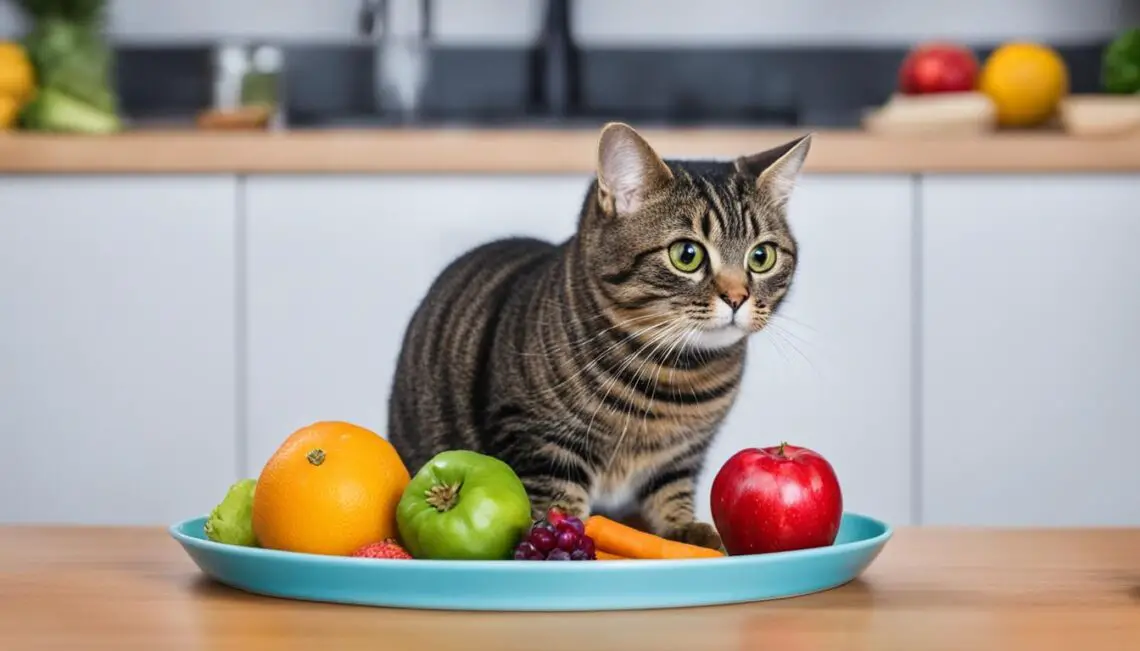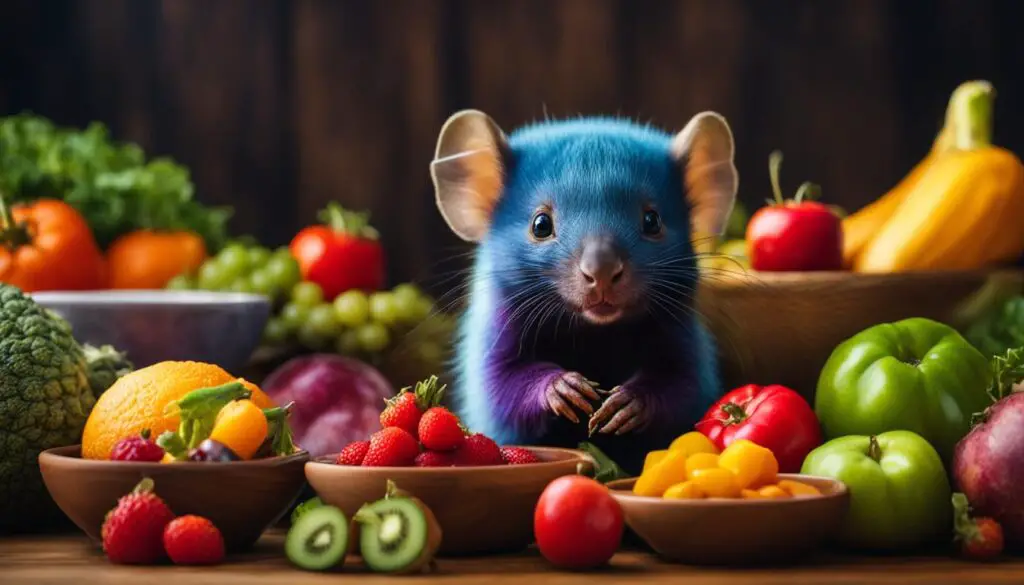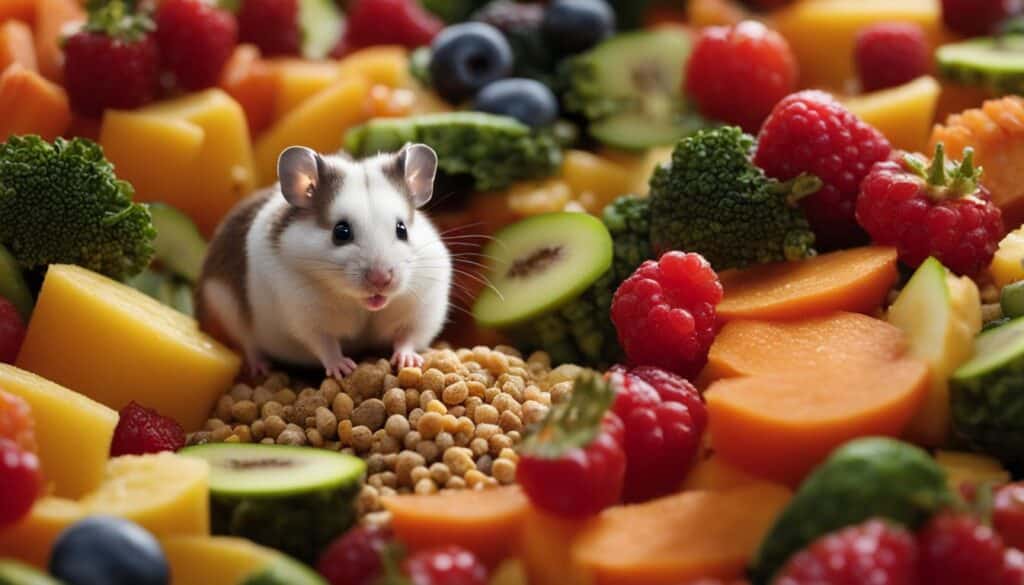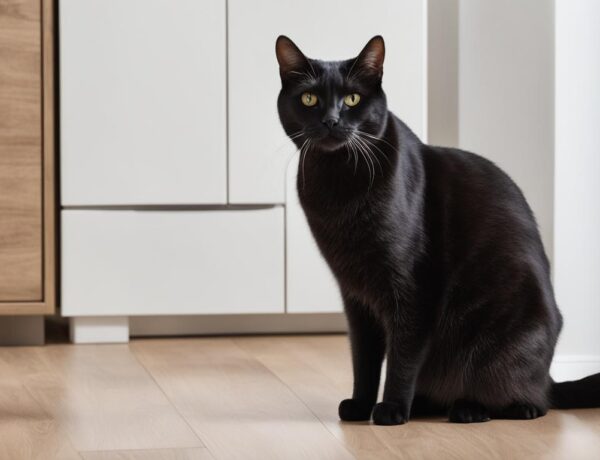When it comes to our small pets, we want them to be happy and healthy. But what do we do when they become fussy eaters? It can be frustrating for pet owners trying to introduce new foods and ensure a balanced diet for their beloved furry companions. However, with the right strategies and a little patience, it is possible to overcome this challenge and successfully transition their dietary preferences.
If your small pet refuses to eat for more than a few days or shows signs of illness, it’s crucial to consult with a veterinarian to rule out any underlying health concerns. Once you’ve received the all-clear, you can start implementing techniques to encourage your picky pet to try new foods and broaden their taste horizons.
Key Takeaways:
- Consult with a vet if your pet refuses to eat or shows signs of illness.
- Implement techniques like timed feeding, enrichment feeding, and offering different textures to introduce new foods to your small pet.
- Add toppers or enhance the smell of the food to make it more enticing.
- Monitor your pet’s treat intake and consider their feeding preferences and environment.
- Be patient and persistent and avoid rapid diet changes.
Timed Feeding Techniques for Picky Small Pets
Timed feeding is an effective strategy for picky small pets to establish a feeding routine and prevent food aversions. This technique involves offering food to your pet at set mealtimes and allowing them a specific amount of time, typically around 15-20 minutes, to eat.
By implementing a timed feeding routine, you provide structure and consistency to your pet’s feeding schedule. This helps prevent food from spoiling or losing its appeal, ensuring that your pet receives fresh and enticing meals.
Having a designated feeding time also encourages your pet to eat promptly. It eliminates the risk of leaving food out for extended periods, which can lead to pickiness or selective eating habits.
During the timed feeding window, offer a measured portion of food appropriate for your pet’s size and dietary needs. If your pet doesn’t finish their meal within the allotted time, remove the food and refrigerate it until the next feeding. This approach prevents your pet from grazing and reinforces the importance of eating at mealtimes.
Timed feeding is particularly beneficial for fastidious eaters who may have specific preferences or aversions to certain foods. It reduces the likelihood of them becoming finicky and encourages them to consume a balanced diet.
Benefits of Timed Feeding:
- Promotes regular feeding routine
- Prevents food spoilage
- Reduces pickiness and food aversions
- Aids in maintaining a healthy weight
I found that implementing a timed feeding routine was a game-changer for my picky chinchilla, Chester. He began eating his meals promptly and showed less resistance to trying new foods. It provided structure and eliminated the stress of worrying about food being left out for extended periods. I highly recommend this technique for small pets with selective eating habits.
To further enhance the effectiveness of timed feeding, consider incorporating enrichment activities during mealtime. This can include puzzle feeders or interactive toys that engage your pet while they enjoy their meal.
Remember, every pet is unique, and it may take some time to find the right feeding routine that suits their preferences and dietary needs. Be patient, observe their behavior, and consult with a veterinarian for guidance if needed.
| Benefits of Timed Feeding |
|---|
| Promotes regular feeding routine |
| Prevents food spoilage |
| Reduces pickiness and food aversions |
| Aids in maintaining a healthy weight |
Enrichment Feeding to Encourage Picky Small Pets
Enrichment feeding is a fantastic way to break the monotony of mealtime for picky small pets and create positive eating experiences. By making their feeding time more interesting and engaging, you can encourage them to try new foods and expand their palate.
One effective method of enrichment feeding is to use puzzle feeders. These interactive toys require pets to solve puzzles or manipulate objects to access their food. Not only does this provide mental stimulation for your pet, but it also slows down their eating pace, allowing them to savor their food and enjoy the experience.
Another way to enrich feeding is by hiding food in toys or mats. This taps into your pet’s natural instinct to forage for food, making mealtime feel like an exciting treasure hunt. Spread their kibble or treats throughout the house, and watch as they eagerly search and discover their hidden rewards.
Scattering food in different areas of the house is yet another method of enrichment feeding. By placing small portions of food in various locations, you can simulate a more natural feeding experience for your pet. This mimics their wild ancestors’ behavior of hunting and gathering, making mealtime an adventure.
Lastly, adding variety to your pet’s feeding methods can also enhance their eating experience. Consider alternating between wet and dry food, introducing different flavors and textures, or even offering fresh fruits and vegetables as occasional treats. This variety can keep your pet excited about mealtime and encourage them to try new foods.
Remember, enrichment feeding is not only about providing physical nourishment but also about creating positive associations and experiences with food. By engaging your picky small pet’s natural instincts and making mealtime more enjoyable, you can help them overcome their fussiness and develop a more diverse and nutritious diet.
The benefits of enrichment feeding:
- Stimulates mental activity and engagement
- Slows down eating pace, aiding digestion
- Provides a sense of satisfaction and accomplishment
- Mimics natural foraging and hunting behavior
- Promotes exploration and environmental interaction
Offering Different Textures for Picky Small Pets
When it comes to picky small pets, some individuals, particularly cats, are more concerned about the texture of their food rather than the taste. To entice these discerning eaters and encourage them to try new foods, offering a variety of texture options can make a significant difference.
Different texture formulations available from high-quality brands can cater to the preferences of picky small pets. Consider incorporating the following texture options into their diet:
- Mousses
- Patés
- Stews
- Gravies
- Jellies
- Loaf-type wet foods
By introducing diverse textures, pet owners can provide a range of sensory experiences that may appeal to their picky eaters. It’s important to experiment with various options to discover which textures are most enticing to the pet.
Here is a visual representation of the different texture options to consider:
| Texture Options |
|---|
| Mousses |
| Patés |
| Stews |
| Gravies |
| Jellies |
| Loaf-type wet foods |
Incorporating these different textures based on the pet’s preferences can help enhance the appeal of their food, making mealtime more enjoyable for both the pet and the owner.
While experimenting with various textures, it’s crucial to ensure that the chosen options provide the necessary nutritional value for the pet’s overall wellbeing. Consulting with a veterinarian can help identify textures that meet the specific dietary needs of picky small pets.
Adding Toppers for Picky Small Pets
When dealing with picky small pets, completely changing their diet can be a challenge. To gradually introduce new flavors and make regular food more enticing, pet owners can consider adding toppers. These additional toppings can help enhance the food flavor and increase the palatability of the meal.
Toppers can include:
- Wet foods: Adding a spoonful of wet food can add moisture and flavor to dry kibble, making it more appealing to picky eaters.
- Cooked meats: Offer small portions of cooked chicken or beef as a topper. This not only introduces different textures but also provides added protein to the diet.
- Freeze-dried treats: Crumbled freeze-dried treats can be sprinkled on top of the regular food, adding a burst of flavor and aroma that entices pets to eat.
- Fresh fruits or vegetables: Small amounts of fresh fruits or vegetables like carrots or blueberries can be chopped and mixed in with the pet’s food, providing added nutrients and variety.
- Flavored probiotic supplements: Probiotic supplements with flavors like chicken or fish can be mixed into the regular food, offering additional health benefits and enticing pets with a taste they enjoy.
It is important to note that the toppers should make up no more than 10% of the pet’s total diet to maintain a balanced nutritional profile. Additionally, it is crucial to avoid fatty treats, raw meat, or milk-based products to prevent digestive issues.
By adding these toppers, pet owners can enhance the food flavor, making it more appealing to picky small pets. It is also worth noting that consulting with a veterinarian is recommended to ensure the toppers align with the pet’s dietary requirements and overall health.
Conclusion
Introducing new foods to fussy small pets can be a challenging process that requires patience and experimentation. As a responsible pet owner, it is important to consider your pet’s unique feeding preferences and take proactive measures to encourage them to try new foods. By utilizing techniques like timed feeding and enrichment feeding, you can create positive experiences that make mealtime more enjoyable for your furry friend.
Offering a variety of textures and flavors can also help enhance the appeal of new foods. Exploring different options such as mousses, stews, and gravies can entice even the pickiest eaters to give unfamiliar foods a chance. Additionally, adding toppers to your pet’s regular diet can provide an extra burst of flavor and make the transition to new foods smoother.
It is crucial to remember that a successful dietary transition takes time and persistence. Avoid making rapid diet changes, as this can disrupt your pet’s digestive system. Consult with your veterinarian to ensure that the new foods you introduce are suitable for your pet’s specific dietary needs.
With your dedication and the right approach, you can help your fussy small pet develop a healthier and more varied diet. By taking the necessary steps and seeking professional guidance when needed, you can ensure a successful dietary transition that promotes your pet’s well-being.
FAQ
How can I introduce new foods to my fussy small pet?
To introduce new foods to your fussy small pet, you can try several strategies such as timed feeding, enrichment feeding, offering different textures, adding toppers to the regular diet, enhancing the smell of the food, monitoring treat intake, and considering the pet’s feeding preferences and environment.
What is timed feeding and how does it help picky small pets?
Timed feeding involves offering food to small pets at set mealtimes and giving them a specific amount of time to eat, usually around 15-20 minutes. This routine helps establish a feeding schedule and prevents food from spoiling or losing its appeal. By providing food within a designated time frame, pets are encouraged to eat and avoid developing aversions or pickiness towards certain foods.
How does enrichment feeding encourage picky small pets to eat?
Enrichment feeding involves making the eating experience more interesting and engaging for picky small pets. This can be achieved by using puzzle feeders, hiding food in toys or mats, scattering food in different areas of the house, or adding variety to feeding methods. By associating positive experiences with mealtime, pets are more likely to be less picky and eat a wider range of foods.
What role does texture play in enticing picky small pets to try new foods?
Some small pets, especially cats, are more focused on the texture of their food rather than the taste. Offering a variety of texture options such as mousses, patés, stews, gravies, jellies, and loaf-type wet foods can entice picky pets to try new foods. It’s important to explore different texture formulations from high-quality brands to cater to the pet’s preferences.
How can I enhance the appeal of my pet’s regular food?
Before completely changing a pet’s diet, owners can consider adding toppers to the regular food to make it more enticing. Toppers can include wet foods, cooked meats like chicken or beef, freeze-dried treats, fresh fruits or vegetables, and flavored probiotic supplements. It’s essential to ensure that the toppers make up less than 10% of the total diet and avoid fatty treats, raw meat, or milk-based products to prevent digestive issues.
What should I keep in mind when introducing new foods to my picky small pet?
Introducing new foods to picky small pets requires patience and experimentation. Owners should consider their pets’ feeding preferences, use techniques like timed feeding and enrichment feeding to create positive experiences, offer different textures, and use toppers to enhance food appeal. It’s important to avoid rapid diet changes and consult with a vet when necessary. With time and persistence, fussy small pets can have successful dietary transitions and enjoy a varied and nutritious diet.







No Comments